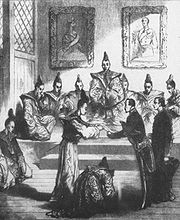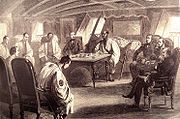
Gustave Duchesne de Bellecourt
Encyclopedia


Asia
Asia is the world's largest and most populous continent, located primarily in the eastern and northern hemispheres. It covers 8.7% of the Earth's total surface area and with approximately 3.879 billion people, it hosts 60% of the world's current human population...
, and especially in Japan
Japan
Japan is an island nation in East Asia. Located in the Pacific Ocean, it lies to the east of the Sea of Japan, China, North Korea, South Korea and Russia, stretching from the Sea of Okhotsk in the north to the East China Sea and Taiwan in the south...
. He was the first French official representative in Japan from 1859 to 1864, following the signature of the Treaty of Amity and Commerce between France and Japan
Treaty of Amity and Commerce between France and Japan
The Treaty of Amity and Commerce between France and Japan was signed in Edo on October 9, 1858, by Jean-Baptiste Louis Gros, the commander of the French expedition in China, assisted by Charles de Chassiron and Alfred de Moges, opening diplomatic relations between the two countries...
in 1858.
China
Gustave de Bellecourt was Secretary of the French legation in China in 1857, under Jean-Baptiste Louis GrosJean-Baptiste Louis Gros
Jean-Baptiste Louis Gros was a French ambassador and one of the first daguerrotypists. Baron and French chargé d'affaires in Bogotá , Athens and Ambassador to London - during which period he also travelled to China and Japan in 1857 and 1858 — he produced many famous daguerrotypes — chief among...
. He participated to the operation against China in the Second Opium War
Second Opium War
The Second Opium War, the Second Anglo-Chinese War, the Second China War, the Arrow War, or the Anglo-French expedition to China, was a war pitting the British Empire and the Second French Empire against the Qing Dynasty of China, lasting from 1856 to 1860...
. In 1858, Gustave Duchesne de Bellecourt arrived in Japan as the secretary of the mission for the Franco-Japanese Treaty of Trade and Amity, led by Jean-Baptiste Louis Gros
Jean-Baptiste Louis Gros
Jean-Baptiste Louis Gros was a French ambassador and one of the first daguerrotypists. Baron and French chargé d'affaires in Bogotá , Athens and Ambassador to London - during which period he also travelled to China and Japan in 1857 and 1858 — he produced many famous daguerrotypes — chief among...
.
Japan career
The following year, he went again to Japan, arriving on 6 September 1859, and became the first French representative in the country, with the title of "Premier ministre plénipotentiaire de France au Japon". He was assisted by the translator Father Girard.
Saikai-ji
, more commonly , is a Japanese temple in 4-16-23, Mita, Minato, Tokyo . Its religious sect and principal image are Pure Land Buddhism and Amitābha respectively....
in Edo
Edo
, also romanized as Yedo or Yeddo, is the former name of the Japanese capital Tokyo, and was the seat of power for the Tokugawa shogunate which ruled Japan from 1603 to 1868...
.
In 1861, Duchesne was promoted to the position of ambassador
Ambassador
An ambassador is the highest ranking diplomat who represents a nation and is usually accredited to a foreign sovereign or government, or to an international organization....
. He was generally in agreement with Rutherford Alcock
Rutherford Alcock
Sir Rutherford Alcock KCB was the first British diplomatic representative to live in Japan.-Early life:Alcock was the son of the physician, Dr. Thomas Alcock, who practised at Ealing, near London. As he grew up, Alcock followed his father into the medical profession...
in his positions against the Bakufu.
In 1863, Duchesne was involved in the negotiations for the reparations following the Namamugi incident
Namamugi Incident
The was a samurai assault on foreign nationals in Japan on September 14, 1862, which resulted in the August 1863 bombardment of Kagoshima, during the Late Tokugawa shogunate...
, in which foreigners were killed by a party from Satsuma.
Duchesne, who had been a witness to Western interventions in China
China
Chinese civilization may refer to:* China for more general discussion of the country.* Chinese culture* Greater China, the transnational community of ethnic Chinese.* History of China* Sinosphere, the area historically affected by Chinese culture...
, was a strong advocate of the use of force to govern relations with Japan. He supported the French intervention in the 20 July 1863 Bombardment of Shimonoseki
Bombardment of Shimonoseki
The Battles for Shimonoseki refers to a series of military engagements in 1863 and 1864, fought to control Shimonoseki Straits by joint naval forces from the Great Britain, France, the Netherlands and the United States, against the Japanese feudal domain of Chōshū, which took place off and on the...
by Captain Benjamin Jaurès
Benjamin Jaurès
Constant Louis Jean Benjamin Jaurès was a 19th-century French Admiral and Senator, who was active in Japan during the Bombardment of Shimonoseki and the Boshin war ....
and the August 1863 armed intervention of the British in the Bombardment of Kagoshima
Bombardment of Kagoshima
The Bombardment of Kagoshima, also known as the , took place on 15–17 August 1863 during the Late Tokugawa shogunate. The British Royal Navy was fired on from the coastal batteries near town of Kagoshima and in retaliation bombarded the town...
.

In 1864, Duchesne de Bellecourt was succeeded at his post in Tokyo by Léon Roches
Léon Roches
Léon Roches was a representative of the French government in Japan from 1864 to 1868.Léon Roches was a student at the Lycée de Tournon in Grenoble, and followed an education in Law...
, heralding an era of much stronger involvement by France.
Tunisia career
Duchesne de Bellecourt was to be sent to TunisTunis
Tunis is the capital of both the Tunisian Republic and the Tunis Governorate. It is Tunisia's largest city, with a population of 728,453 as of 2004; the greater metropolitan area holds some 2,412,500 inhabitants....
, as Consul-General.
Gustave Duchesne de Bellecourt received the medal of the Légion d'Honneur
Légion d'honneur
The Legion of Honour, or in full the National Order of the Legion of Honour is a French order established by Napoleon Bonaparte, First Consul of the Consulat which succeeded to the First Republic, on 19 May 1802...
.
Publications
- La colonie de Saïgon: les agrandissements de la France dans le Bassin du Mekong http://books.google.com/books?id=CMTBAB-D2soC&pg=PA234
See also
- List of Ambassadors from France to Japan
- France-Japan relations (19th century)France-Japan relations (19th century)The development of France-Japan relations in the 19th century coincided with Japan's opening to the Western world, following two centuries of seclusion under the "Sakoku" system and France's expansionist policy in Asia. The two countries became very important partners from the second half of the...

